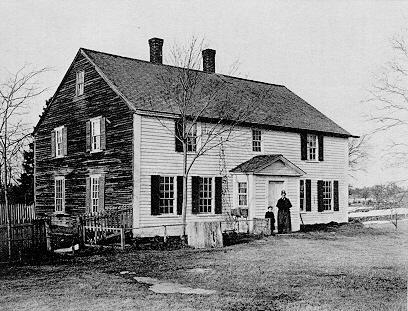Special to the Atlantic News
By Skip Webb
Atlantic News, Friday, May 5, 2006
[The following article is courtesy of Atlantic News]

[Photo from Joseph Dow's "History of the Town of Hampton,
1638-1892 and not in original article]
HAMPTON -- During its first 11 years, the James House Association, Inc. concentrated on the preservation of the house, having the homestead registered as a National Historic Site. The association also worked toward the completion of several research projects required by the "Secretary of the Interior Rules for Preservation and Restoration of a National Historic Site."
Deteriorated wood stove chimneys were removed, a new roof and fascia were applied, and plaster was removed from the interior to expose the frame for inspection and education.
The 1705 "ell" and the back of the house underwent extreme preservation and partial restoration, and the preservation of the entire frame was completed.
Two reports documenting the history of the James House, its structure and its inhabitants were published. "A Historic Structures Report," a landscape historical study, a subsurface survey of the entire three-acre site, and a genealogy of the James family were completed. Several archaeological digs were performed, and research to create educational programs was in process.
The first 11 years can be called the preservation and research period. During this time frame, the public was invited to visit the homestead and tour the house, to receive basic knowledge of 18th century construction, to learn the house's history and about its inhabitants. An educational program was made available to education Hampton Academy and North Hampton School students about First Period construction, early carpentry, 18th century farming, archaeology and salt marsh haying.
An honors history program was offered through Winnacunnet High School and some special programs were offered to the public, all of which were based on the James House, its families and early social and economic influences affecting the homestead and its inhabitants. Some special programs were also provided.
Now in its 11th year, the James House Association has begun its decision and implementation period. Emphasis is now being placed on restoration and/ or replacement of windows in, and the application of, siding to the house. The siding has been cut, but it must be nailed to the structure; to that end, the association is actively seeking a grantor or funding partner to fund this part of the project.
The association is reviewing the results of the landscape research, the subsurface surveys, and the archaeological findings to decide how to form a landscape which will best tell the history of the James Homestead. A landscape which will include orchards as well as historical herb and flower gardens is included in the vision.
The outlining of buildings which were on the site in the pat is being considered. The clearing of two acres of woods, while saving historical trees and plants which will help tell the James House story, has begun. Arrangements to open a well to provide water to the site are being planed.
The association is recruiting volunteers or other organizations who would be interested in helping clear, plant and/ or maintain the landscape. The association is also actively looking for a grantor or funding partner for the landscaping effort.
Also being discussed is installation of a sound barrier to protect the property from I-95 noise and the addition to the property of a reception center with a classroom and restrooms. Before these projects can be implemented, archaeological digs will have to be performed in the areas where they would be built.
As it is a rule governing National Historic Sites and the policy of the James House Association that archaeological work must be performed before any piece of a site is disturbed in any way, the association is actively seeking a grantor or funding partner for this archaeological effort as well.
Simultaneously, the association is developing plans to broaden its educational programs, through the schools and to the public, at the James House and at the location of other organizations. As the house is restored and the landscaping becomes a reality, the amount and quality of the education programs will improve. This is evidenced by the recent addition of the "Lives Past Lived" and "Dense Woods to Historical Landscape" programs.
Any individual or organization interested in helping the James House Association implement its future plans can obtain additional information from the recently-expanded and updated Web site at www.jameshousemuseum.org, or by calling (603) 926-3851.
